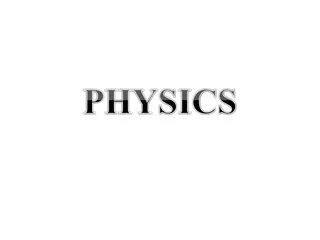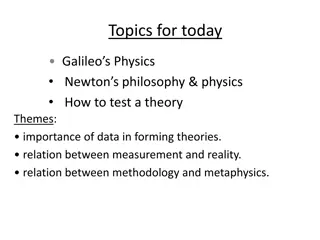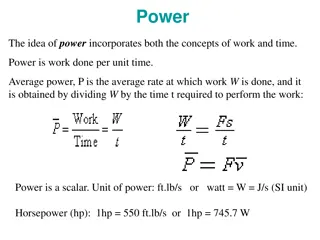Understanding Power and Work in Physics
Power in physics is defined as the rate at which work is done, incorporating concepts of both work and time. This involves calculating average power, unit of power, human metabolic rates for various activities, force versus distance graphs, work done by variable force, and practical examples like the compound bow. Explore the relationship between force, work, and power through graphical representations and calculations.
Download Presentation

Please find below an Image/Link to download the presentation.
The content on the website is provided AS IS for your information and personal use only. It may not be sold, licensed, or shared on other websites without obtaining consent from the author. Download presentation by click this link. If you encounter any issues during the download, it is possible that the publisher has removed the file from their server.
E N D
Presentation Transcript
6.7 Power The idea of power incorporates both the concepts of work and time. Power is work done per unit time. Average power, P is the average rate at which work W is done, and it is obtained by dividing W by the time t required to perform the work: Power is a scalar. Unit of power: ft.lb/s or watt = W = J/s (SI unit) Horsepower (hp): 1hp = 550 ft.lb/s or 1hp = 745.7 W
Human Metabolic Rates Activity Rate (watts) Running (15 km/h) 1340 W Skiing 1050 W Biking 530 W Walking (5 km/h) 280 W Sleeping 77 W
Force versus Distance Graph Work = Area under the Force versus Displacement graph
Work Done by a Variable Force The work done by a variable force in moving an object is equal to the area under the graph of F cos versus s.
Work and the Compound Bow Find the work that the archer must do in drawing back the string of the compound bow in Figure 6.22 from 0 to 0.500 m.
Problem 71 The drawing shows the force-versus-displacement graph for two different bows. These graphs give the force that an archer must apply to draw the bowstring. (a) For which bow is more work required to draw the bow fully from S = 0 to S = 0.5m? Give your reasoning. (b) Estimate the additional work required for the bow identified in part (a) compared to the other bow.























